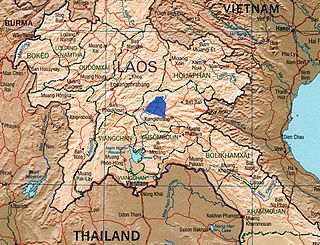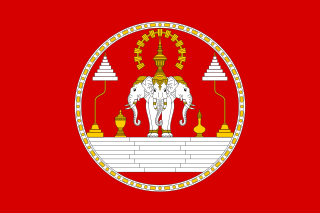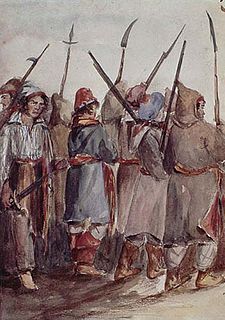Operation Pigfat was a crucial guerrilla offensive of the Laotian Civil War; it lasted from 26 November 1968 to 7 January 1969. Launched by Hmong tribal soldiers backed by the Central Intelligence Agency, it was based on the usage of overwhelming air power to clear the path for the guerrillas. The guerrillas were faced with the largest concentration of Vietnamese communist troops stationed outside Vietnam, and hoped to spoil that imminent attack.
Forces Armées Neutralistes was an armed political movement of the Laotian Civil War. Founded upon the basis of the mutinous Bataillon Parachustistes 2 that lost the Battle of Vientiane, FAN's original stance was that of its commander, Captain Kong Le, who espoused strict neutrality for the Kingdom of Laos and an end to governmental corruption. Withdrawing from Vientiane in defeat on 16 December 1960, FAN occupied the Plain of Jars; their major center was the all-weather airstrip at Muang Soui. The following year was spent in conflict with Royalist guerrillas. During 1961, FAN grew to a strength of 8,000; it had a company of tanks and a small air arm. However, it was hampered by inadequate supplies erratically passed along by the Pathet Lao communists.
Kou Kiet was a major Laotian Civil War victory for the anti-communist troops of the Kingdom of Laos. Patterned after prior Operation Raindance, it depended upon extensive air strikes blasting communist units and clearing them from the path of the Royalist offensive. Powered by 150 daylight and 50 night sorties daily, with 50 to 80 day strikes directed by Raven Forward Air Controllers, Kou Kiet ran from 6 August to 30 September 1969. It was successful beyond expectations. After the Royal Lao Government troops achieved their objectives, General Vang Pao insisted on pushing forward while they had the initiative. As a result, the Royalists regained control of the entire Plain of Jars while also capturing a huge stock of munitions from the communists. Their triumph came at a cost. However successful the Royalists were, by battle's end their battle-worn forces had exhausted their pool of potential recruits, while the Vietnamese could easily replace their personnel losses.
Operation Junction City Jr. was a major Laotian offensive of the Vietnam War; initially aimed at temporary disruption of the Ho Chi Minh Trail, it was extended into an attempt to isolate the major North Vietnamese communist transshipment point at Tchepone from the units it was supposed to supply.
Operation Left Jab was the first military offensive launched against the Sihanouk Trail extension of the Ho Chi Minh Trail during the Second Indochina War. It was the first battalion-sized operation waged by the Royal Lao Army against the communists. Carried out between 21 and 26 June 1969, the assault interdicted Route 110 of the Sihanouk Trail for its planned three-day stoppage of military supplies. The Royalist guerrillas of Special Guerrilla Unit 2 then evaded an approaching counterattack and regrouped in friendly territory. Operation Left Jab had cleared the way for Operation Diamond Arrow.
Operation Honorable Dragon was an offensive of the Second Indochina War. The Central Intelligence Agency, which equipped and trained the needed troops, aimed at disruption of the North Vietnamese communist supply line, the Ho Chi Minh Trail. Launched by six battalions of Royal Lao Army military irregulars on 31 August 1970, the operation achieved only limited success. Although the planned objective was captured on 25 September, the offensive was plagued by desertions and combat refusals, including a battalion that ran from "ghosts". After the conquest of Pakse Site 26, troops of the People's Army of Vietnam (PAVN) harassed the Lao occupiers through mid-December 1970.
Campaign 139 was a major military offensive of the People's Army of Vietnam, launched against its Royalist enemies during the Laotian Civil War. Larger than previous invading forces, Campaign 139 was also a combined arms expedition containing tanks, artillery, engineers, and Dac Cong sappers. As such, it was a decided escalation in the war. It was also an exceptional rainy season offensive by PAVN, which usually withdrew during the wet season.
The Tchepone Operation was an interdiction campaign by the Royal Lao Armed Forces aimed at disrupting the People's Army of Vietnam (PAVN) supply line, the Ho Chi Minh trail. The pair of three-battalion Central Intelligence Agency-sponsored Royalist irregulars aimed at a communist garrison at Moung Phine, and the vital transshipment point of Tchepone. The Muang Phine thrust was fruitless. The Tchepone column stalled on Route 9 only 13 kilometers from the logistics center on 31 October. Between 1 and 10 November, the PAVN fiercely attacked while reinforced with nine antiaircraft guns and six mortars. The Royalist guerrillas retreated to base under cover of tactical air strikes by the Royal Lao Air Force and U.S. Air Force that inflicted heavy casualties on the PAVN, including close air support delivered within 20 meters of the Royalists. Analysis of the results of the Tchepone Operation convinced the CIA that regimental operations should replace multi-battalion ones.
Operation Counterpunch, waged 26 September 1970 to 7 January 1971, was a military offensive of the Laotian Civil War. Royalist General Vang Pao's guerrilla army regained the vital all-weather forward fighter base at Muang Soui on the Plain of Jars from the People's Army of Vietnam (PAVN). The preemptive Counterpunch was credited with delaying an imminent PAVN wet season offensive for a month. The guerrilla army survived, though still heavily outnumbered by the PAVN.
Operation Silver Buckle, an offensive staged in Military Region 4 of the Kingdom of Laos, was the deepest Royal Lao Armed Forces penetration to date of the Ho Chi Minh Trail. Reaching the Trailside village of Moung Nong, the forward two companies attacked the rear of the 50,000 People's Army of Vietnam (PAVN) garrison on 8 February 1971, just as Operation Lam Son 719 was launched by the Army of the Republic of Vietnam (ARVN). Overrun and scattered while suffering serious casualties, the Groupement Mobile 30 irregular regiment of Silver Buckle had tied up at least six PAVN battalions, preventing them from opposing Lam Son 719.
Operation Phiboonpol was a "short but very intense engagement" of the Laotian Civil War. Five Royal Lao Government battalions went on the offensive in Military Region 4 of the Kingdom of Laos to try to regain the Boloven Plateau, which overlooked the vital Ho Chi Minh Trail lying to its east. Stopped in its tracks by the People's Army of Vietnam, with its first use of tanks in southern Laos, the Royalists held firm while close air support inflicted heavy casualties on North Vietnamese attackers. A Thai mercenary company sent as a Royalist relief force was ambushed and wiped out. For weeks after the battle, vultures feasted on unburied corpses.
Operation Bedrock (Laos) was a military offensive staged by the Royal Lao Armed Forces against the People's Army of Vietnam in Military Region 4 of the Kingdom of Laos. Its purpose was disruption of the supply of rice to Communist forces occupying the Ho Chi Minh Trail. It was successful.
Operation Sayasila was a major offensive military operation of the Laotian Civil War. It was staged by command of King Sisavang Vatthana. Launched on 26 July 1971 against the Ho Chi Minh Trail complex and its People's Army of Vietnam (PAVN) garrison, Sayasila was planned as a rather complex two phase operation dependent on coordinating two columns containing 4,400 troops with close air support in an attack on 1,100 Vietnamese Communist soldiers. When the assault stalled in mid-August, it was elaborated upon with two additional helilifts of Royalist troops behind the PAVN's mobile garrison. When the Royalist command failed to coordinate tactical movements among its various columns, the PAVN 9th Regiment moved to defeat Royalist aggressor columns one at a time. By 1 September, this Royalist attack had also failed.

Campaign Z was a military offensive by the People's Army of Vietnam; it was a combined arms thrust designed to defeat the last Royal Lao Army troops defending the Kingdom of Laos. The Communist assault took Skyline Ridge overlooking the vital Royalist base of Long Tieng and forced restationing of Royalist aviation assets and civilian refugees. However, Communist forces eventually receded back onto their lines of communication without capturing the base.
Operation Strength II was a Royalist military offensive of the Laotian Civil War. It was devised as another diversion in the mode of the original Operation Strength. Planned as a pincer movement on the Plain of Jars, Operation Strength II's beginning was grossly hampered by combat refusals and desertions from one of its two task forces. Loss of tactical air support as the Easter Offensive began in South Vietnam also weakened the Laotian effort. In any event, neither pincer did much toward its goal of distracting the People's Army of Vietnam from its attempts to overrun the strategic guerrilla base at Long Tieng and end the war.
Operation Phou Phiang II was one of the final battles of the Laotian Civil War. It was an attempt to relieve the siege on the guerrilla headquarters at Long Tieng on the Plain of Jars. Planned with the backing of Henry Kissinger, it was designed as a two phase attack consisting of five task forces of Thai mercenaries and Royalist guerrillas upon the People's Army of Vietnam invading Laos. Air superiority was used to direct over 100 air strike sorties daily to support the offense, and air mobility to shuffle attacking troops. A new radar bombing program by F-111 Aardvarks and B-52 Stratofortresses failed to cripple the Communist forces. Designed to overwhelm Communist defenses with its multiplicity, the five Lao task forces were defeated in detail by the Communists despite two new columns being improvised and introduced into the fray.
Operation Phou Phiang III was the final offensive of the Laotian Civil War by the Royal Lao Army's L'Armée Clandestine. Central Intelligence Agency-sponsored Hmong guerrillas and Thai mercenaries formed three attacking task forces in an attempt to clear the People's Army of Vietnam from positions near the Royalist guerrillas' headquarters on the Plain of Jars. All three columns failed to move the Vietnamese invaders before the ceasefire of 21 February 1973 ended the war.
Operation Black Lion was a Royal Lao Government counter-offensive against a People's Army of Vietnam thrust that cut the Kingdom of Laos in two at Khong Sedone during May 1972. Two regiments of Royalist military irregulars retaliated on 15 June 1972, attacking the Communist 39th Regiment in an air assault while Royal Lao Air Force tactical air strikes hammered the 39th. During the next month, the 39th Regiment would suffer an estimated 360 casualties and be rendered ineffective for attacks. On 18 July, they retreated, leaving a rear guard to be overrun.
The Battles of Bouamlong came about because the valley of Bouamlong was a center of Royalist guerrilla operations during the Laotian Civil War. Located well into Communist-held territory and maintained by an air bridge, on several occasions Bouamlong served as a launching point for Royalist offensives such as Operation Raindance, Kou Kiet, Operation Counterpunch III, and Operation Strength. It was also targeted for attack by offensives by the People's Army of Vietnam during Campaign 139 and Campaign 74B. Defended by Auto Defense Choc troops led by Major Cher Pao Moua, Bouamlong held out against the Communist forces even after the War ended in a ceasefire in February 1973. There were reports of resistance into the 1990s.
Unity was the code name for Thailand's covert supply of mercenary soldiers to the Kingdom of Laos during the Laotian Civil War. From 4 July 1964 until March 1973, battalions of Thai volunteers fought Communist insurgents on the Plain of Jars in Military Region 2. As the Hmong L'Armée Clandestine was sapped by ongoing casualties and a limited basis for replacements, Unity battalions replaced them.













